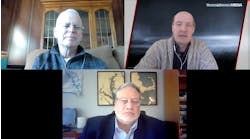"With the passage of ISTEA, we were able to stress preventive maintenance more within the department," said Kevin Herritt, structural section and design standards specialist in Caltrans' State and Local Project Development Program.
"After the [Loma Prieta Earthquake] in '89 and the Northridge earthquake following soon after, we had a lot of needs to address from a safety standpoint," he said. "Seismic retrofit became the highest priority work within the department." As the department meets more of its seismic retrofit needs, Herritt said more funds have been made available for nonseismic projects.
In 1996, the state began implementation of its Capital Maintenance Program (CAP-M), a five-year plan that involves the use of concrete pavement restoration techniques and asphalt overlays on selected pavements. Through July 1996, Caltrans had let $100 million in contract awards involving 31 projects. The objective of the CAP-M is to target projects that do not involve a great deal of attention to off-road matters. "The key to the program is trying to focus the funding on the pavement itself," said Herritt.
Grinding extends life
Of the 31 projects awarded in the first half of '96, 10 were diamond-grinding-only projects. For the year, diamond grinding was performed on 670 lane miles of state-owned concrete pavement. In 1997 diamond grinding will be performed throughout the state, but there will be fewer in number than in 1996, said Tom Pyle, a pavement management engineer for Caltrans.
The diamond grinding let as part of the CAP-M program is a maintenance technique that extends the useful life of the pavement. This is accomplished through milling off a portion of the surface layer of PCC pavement, which provides a smoother riding surface and corrects slab curl.
Although Caltrans has employed diamond grinding in past years, Herritt said ISTEA has enabled the department to re-emphasize the technique and in turn delay the necessity of performing major reconstruction on the pavements.
"Diamond grinding offers a definite savings over replacing," says Caltrans' Pyle. "You spend a little bit of money and people think it's a new pavement." Diamond grinding provides a smooth ride that often can exceed that of new pavement.
In California, concrete diamond grinding candidates include pavement with 2% or fewer of the slabs having three or more cracks and a Cox ride score below 20.
For rehabbed PCC pavements, the department is planning to lengthen its 10-plus year extension of surface pavement life philosophy to 20 to 25 years before major rehabilitation becomes necessary.
Field practice
Taking part in four of the diamond- grinding projects, totaling more than $15 million in contracts for 1996 and 1997 is Highway Services Inc., Rogers, Minn., which is in a joint venture with Penhall Co., a California-based contractor. The joint venture is responsible for diamond grinding nearly 3 million sq yd of concrete in California.
Public perception of the smoothness of highway pavements also is an important part of the diamond grinding equation. "The public judges the road by the seat of their pants," says Gary Aamold, president of Highway Services.
According to Aamold, the California program accounted for approximately one-third of the company's volume for 1996. The company, which performs work throughout the U.S., completed its contract work in California in February.
The last project performed by Highway Services involved a 905,372 sq yd job on IÐ8 near El Centro on the California-Mexican border. The joint venture was a subcontractor to Granite Construction on the project. "The El Centro job was particularly challenging," said Pete Lewis, Highway Services' vice president of operations. "The panels on job were all curled, which made it difficult for the machines and difficult to determine the depth of cut. The aggregates used also were hard and abrasive."
Additional projects included work on IÐ5 near Sacramento, where the joint venture was the prime contractor, and IÐ5 near the Oregon border.
Highway Services used five Cushion Cut PC-5000 diamond grinding machines on its projects. Each machine was fitted with a 4-ft cutter head containing 245 blades.
Aside from initial adjustments to the aggregate used in the pavements, environmental issues, such handling grinding slurry, required the most attention in the California work, according to Aamold. Slurry disposal was a key issue for Pavement Specialists Inc., another diamond grinding contractor, that restored ride on IÐ80 near Dixon, Calif., this winter. "We are particularly pleased that the state provided a disposal area for grinding slurry on the project," said Casey Holloway, vice president of Pavement Specialists.
"The job is going very well," Holloway said while the 80,000-sq-yd IÐ80 project was ongoing. The project was completed in January. Diamond grinding on IÐ80 has areas of heavy cuts due to additional pavement wear from truck tire chains. Typically, diamond grinding removes less than 1/4 in. average depth of the existing concrete surface.
Prior to the IÐ80 project, Pavement Specialists also ground 100,000 sq yd of pavement on IÐ8 near El Centro.
"We just haven't done grinding to such a large extent before," Caltrans' Pyle says. "We have pavements built in the '60s, which have had a wonderful life to them. Now we're able to grind and spend just a little bit of money and get a lot of [benefit]."


